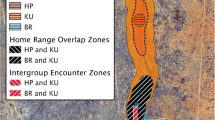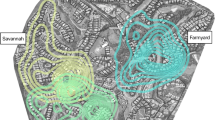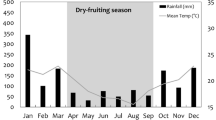Abstract
It is common that neighboring groups of the same species use some of the same areas, resulting in home-range overlap. Areas between the home ranges of neighboring groups not used by either group (no-use zone or NUZ) are rarely reported. Here, we report the existence of a NUZ between the home ranges of two Geoffroy’s spider monkey groups, and examine its spatial changes over time and the ecological and behavioral underpinnings of such phenomenon. Although its size and location changed between 2017 and 2022, the NUZ was always present. We did not find any differences in the vegetation structure and composition between the NUZ and the ranging areas and in the monkeys’ activity patterns between areas adjacent to the NUZ and the other parts of the ranging areas. The number of monkey vocalizations was lower and subgroup size was smaller (although the number of males did not differ) in areas adjacent to the NUZ than in the other parts of the ranging areas. Both changes possibly reflect the tendency to conceal their presence to the neighboring group. Our findings contribute to the understanding of primate space use and highlight the need to focus on the areas delimiting home ranges.



Similar content being viewed by others
Data availability
The data analyzed in this paper are available from the authors upon request.
References
Altmann J (1974) Observational study of behavior: sampling methods. Behaviour 49(3):227–267. https://doi.org/10.1163/156853974x00534
Aureli F, Schaffner CM (2008) Social interactions, social relationships and the social system of spider monkeys. In: Campbell CJ (ed) Spider monkeys: Behavior, ecology and evolution of the genus Ateles. Cambridge University Press, Cambridge
Aureli F, Schaffner CM (2010) Spider monkeys. Curr Biol 20(15):R624–R626. https://doi.org/10.1016/j.cub.2010.06.040
Aureli F, Schaffner CM, Verpooten J, Slater K, Ramos-Fernandez G (2006) Raiding parties of male spider monkeys: insights into human warfare? Am J Phys Anthropol 497(May):486–497
Aureli F, Schaffner CM, Boesch C, Simon K, Call J, Chapman CA, Connor R, Di Fiore A, Dunbar RIM, Henzi SP, Holekamp K, Amanda H, Layton R, Lee P, Lehmann J, Joseph H, Ramos-Fernandez G, Strier KB, van Schaik CP (2008) Fission–fusion dynamics new research frameworks. Curr Anthropol 49(4):627–654. https://doi.org/10.1086/586708
Briseno-Jaramillo M, Ramos-Fernandez G, Palacios-Romo TM, Sosa-López JR, Lemasson A (2018) Age and social affinity effects on contact call interactions in free-ranging spider monkeys. Behav Ecol Sociobiol 72(12):192. https://doi.org/10.1007/s00265-018-2615-2
Briseño-Jaramillo M, Sosa-López JR, Ramos-Fernandez G, Lemasson A (2022) Flexible use of contact calls in a species with high fission–fusion dynamics. Philos Trans R Soc B Biol Sci 377(1860):20210309. https://doi.org/10.1098/rstb.2021.0309
Busia L, Schaffner CM, Aureli F (2017) Relationship quality affects fission decisions in wild spider monkeys (Ateles geoffroyi). Ethol 123(6–7):405–411. https://doi.org/10.1111/eth.12609
Busia L, Smith-Aguilar SE, Aureli F, Schaffner CM, Ramos-Fernandez G (2018) Predation attacks on wild spider monkeys (Ateles geoffroyi). Folia Primatol 89(5):341–346. https://doi.org/10.1159/000492055
Castro Marin G, Nygår R, González Rivas B, Oden PC (2005) Stand dynamics and basal area change in a tropical dry forest reserve in Nicaragua. For Ecol Manag 208(1–3):63–75. https://doi.org/10.1016/j.foreco.2004.10.072
Ceccarelli E, Negrín AR, Coyohua-Fuentes A, Canales-Espinosa D, Dias PAD (2019) An exploration of the factors influencing the spatial behavior of mantled howler monkeys (Alouatta palliata). Int J Primatol 40:197–213. https://doi.org/10.1007/s10764-018-0075-1
Chapman CA (1990) Association patterns of spider monkeys: the influence of ecology and sex on social organization. Behav Ecol Sociobiol 26(6):409–414. https://doi.org/10.1007/BF00170898
Croft DP, James R, Krause J (2008) Exploring animal social networks. Princeton University Press, Princeton
Davison AC, Hinkley DV (1997) Bootstrap methods and their application. Cambridge University Press, Cambridge
Durán R, Campos G, Trejo JC, Simá P, May‐Pat F, Qui MJ (2000) Listado Florístico de la Península de Yucatán. Centro de Investigación Científica de Yucatán, A.C., Mérida.
González-Zamora A, Arroyo-Rodríguez V, Chaves OM, Sánchez-López S, Stoner KE, Riba-Hernández P (2009) Diet of spider monkeys (Ateles geoffroyi) in Mesoamerica: current knowledge and future directions. Am J Primatol 71(1):8–20. https://doi.org/10.1002/ajp.20625
Hartig F (2022) DHARMa: Residual Diagnostics for Hierarchical (Multi-Level/Mixed) Regression Models. R package version 0.4.6. http://florianhartig.github.io/DHARMa/
Lappan S, Malaivijitnond S, Radhakrishna S, Riley EP, Ruppert N (2020) The human–primate interface in the New Normal: Challenges and opportunities for primatologists in the COVID-19 era and beyond. Am J Primatol 82(8):e23176. https://doi.org/10.1002/ajp.23176
Link A, Di Fiore A (2013) Effects of predation risk on the grouping patterns of white-bellied spider monkeys (Ateles belzebuth belzebuth) in Western Amazonia. Am J Phys Anthropol 150(4):579–590. https://doi.org/10.1002/ajpa.22230
MacMahon JA, Mull JF, Crist TO (2000) Harvester ants (Pogonomyrmex spp.): their community and ecosystem influences. Annu Rev Ecol Evol Syst 31(1):265–291. https://doi.org/10.1146/annurev.ecolsys.31.1.265
Majolo B, deBortoli VA, Martínez- Íñigo L, Lehmann J (2020) Effect of group size and individual characteristics on intergroup encounters in primates. Int J Primatol 41:325–341. https://doi.org/10.1007/s10764-019-00119-5
Pearce F, Carbone C, Cowlishaw G, Isaac NJB (2013) Space-use scaling and home range overlap in primates. Proc R Soc B Biol Sci. https://doi.org/10.1098/rspb.2012.2122
R Core Team (2023) R: A language and environment for statistical computing. R Foundation for Statistical Computing. https://www.r-project.org/
Ramos-Fernandez G (2005) Vocal communication in a fission–fusion society: do spider monkeys stay in touch with close associates? Int J Primatol 26(5):1077–1092. https://doi.org/10.1007/s10764-005-6459-z
Ramos-Fernandez G, Ayala-Orozco B (2003) Population size and habitat use of spider monkeys at Punta Laguna, Mexico. In: Marsh LK (ed) Primates in Fragments. Springer, Boston
Ramos-Fernandez G, Smith-Aguilar SE, Schaffner CM, Vick LG, Aureli F (2013) Site fidelity in space use by spider monkeys (Ateles geoffroyi) in the Yucatan Peninsula. Mexico Plos ONE 8(5):e62813. https://doi.org/10.1371/journal.pone.0062813
Ripley B, Venables B, Bates DM, Hornik K, Gebhardt A, Firth D, Ripley MB (2013) Package ‘mass’. R package version 7.3–57. https://cran.r-project.org/web/packages/MASS/index.html
Saldaña-Sánchez AA, Schaffner CM, Smith-Aguilar S, Aureli F (2022) Not just females: the socio-ecology of social interactions between spider monkey males. Proc R Soc B Biol Sci 289(1978):1–8. https://doi.org/10.1098/rspb.2021.2808
Schaffner CM, Rebecchini L, Ramos-Fernandez G, Vick LG, Aureli F (2012) Spider monkeys (Ateles geoffroyi yucatenensis) cope with the negative consequences of hurricanes through changes in diet, activity budget, and fission–fusion dynamics. Int J Primatol 33(4):922–936. https://doi.org/10.1007/s10764-012-9621-4
Shimooka Y, Campbell CJ, Di Fiore A, Felton AM, Izawa K, Link A, Nishimura A, Ramos-Fernàndez G, Wallace RB (2008) Demography and group composition of Ateles. In: Campbell CJ (ed) Spider monkeys: Behavior, ecology and evolution of the genus Ateles. Cambridge University Press, Cambridge
Smith JM, Price GR (1973) The logic of animal conflict. Nature 246:15–18
Sobral G, Fuzessy LF, de Oliveira CA (2023) The challenge of coexistence: changes in activity budget and ranging behaviour of brown howler monkeys in response to the presence of conspecifics and heterospecifics. Int J Primatol 44:558–580. https://doi.org/10.1007/s10764-023-00359-6
Soini P (1982) Ecology and population dynamics of the pygmy marmoset, Cebuella pygmaea. Folia Primatol 39:1–21. https://doi.org/10.1159/000156066
Spaan D, Burke C, McAree O, Aureli F, Rangel-Rivera CE, Hutschenreiter A, Longmore SN, McWhirter PR, Wich SA (2019) Thermal infrared imaging from drones offers a major advance for spider monkey surveys. Drones. https://doi.org/10.3390/drones3020034
Symington MM (1988) Demography, ranging patterns, and activity budgets of black spider monkeys (Ateles paniscus charnek) in the Manu National Park, Peru. Am J Primatol 15:45–67. https://doi.org/10.1002/ajp.1350150106
Symington MM (1990) Fission–fusion social organization in Ateles and pan. Int J Primatol 11(1):47–61. https://doi.org/10.1007/BF02193695
Tórrez-Herrera LL, Davis GH, Crofoot MC (2019) Do monkeys avoid areas of home range overlap because they are dangerous? A test of the Risk Hypothesis in white-faced capuchin monkeys (Cebus capucinus). Int J Primatol 41:246–264. https://doi.org/10.1007/s10764-019-00110-0
Van Roosmalen MGM (1985) Habitat preferences, diet, feeding strategy and social organization of the black spider monkey (Ateles paniscus paniscus) in Surinam. Acta Amaz 15:1–236. https://doi.org/10.1590/1809-43921985155238
Van Belle S, Grueter CC, Furuichi T (2020) Dynamics of intergroup relationships in primates: introduction to the special issue. Int J Primatol 41:163–170
Wallace RB (2008) Factors influencing spider monkey habitat use and ranging patterns. In: Campbell CJ (ed) Spider monkeys: Behavior, ecology and evolution of the genus Ateles. Cambridge University Press, Cambridge
Wallace RB (2008b) Towing the party line: territoriality, risky boundaries and male group size in spider monkey fission–fusion societies. Am J Primatol 70(3):271–281. https://doi.org/10.1002/ajp.20484
White L, Edwards A (2000) Vegetation inventory and description. In: White L, Edwards A (eds) Conservation research in the African rain forests: a technical handbook. Wildlife Conservation Society, New York, pp 115–151
Wilson RF, Marsh H, Winter J (2007) Importance of canopy connectivity for home range and movements of the rainforest arboreal ringtail possum (Hemibelideus lemuroides). Wildl Res 34(3):177–184. https://doi.org/10.1071/WR06114
Wrangham R, Crofoot M, Lundy R, Gilby I (2007) Use of overlap zones among group-living primates: a test of the risk hypothesis. Behav 144(12):1599–1619. https://doi.org/10.1163/156853907782512092
Yee TW (2022) VGAM: Vector Generalized Linear and Additive Model R package version: 1.1–7. https://cran.r-project.org/web/packages/VGAM/index.html
Zuur AF (2009) Mixed effects models and extensions in ecology with R. Springer, New York
Acknowledgements
We thank Cecilia Cahum Cahum, Romina María Yitani Medina, Michelle Adair Montalvo Cervantes, Samantha Lucrecia del Valle Ismael, Mónica Margarita Maravert Solano, Bac Yaroslab Becerril Vargas and Avelino Caamal for their assistance in data collection. We thank Los Árboles Tulum for permission and logistical and financial support to perform field work. Research complied with protocols approved by the Secretaría del Medio Ambiente y Recursos Naturales (SEMARNAT: SGPA/DGVS/10405/15, SGPA/DGVS/03005/19, and SGPA/DGVS/07570/21). We thank the Secretaría de Educación Pública for a PRODEP postdoctoral fellowship to DS (511-6/18-1891). We are also thankful to the editors and the two anonymous reviewers for helpful discussions and constructive comments on the manuscript.
Funding
The authors have no financial interests to declare.
Author information
Authors and Affiliations
Contributions
Conceptualization: FA, AASS, DS, EP; Methodology: FA, DS, EP; Formal analysis and investigation: DS, EP; Writing-original draft preparation: AASS, EP; Writing-review and editing: FA, DS; Funding acquisition: FA, DS.
Corresponding authors
Ethics declarations
Conflict of interest
The authors have no competing interests to declare.
Ethical approval
Research complied with protocols approved by the Secretaría del Medio Ambiente y Recursos Naturales (SEMARNAT: SGPA/DGVS/10405/15, SGPA/DGVS/03005/19, and SGPA/DGVS/07570/21). This study was strictly observational in nature and conforms to the International Primatological Society principles of good practice for field primatology. A minimum distance of 10 m was maintained between the monkeys and the observers at all times to minimize the chance of transmission of infectious diseases (Lappan et al. 2020).
Additional information
Publisher's Note
Springer Nature remains neutral with regard to jurisdictional claims in published maps and institutional affiliations.
About this article
Cite this article
Pietrangeli, E., Saldaña-Sánchez, A.A., Spaan, D. et al. Let’s not use it! A dynamic no-use zone between the home ranges of two spider monkey groups. Primates 65, 173–181 (2024). https://doi.org/10.1007/s10329-024-01119-7
Received:
Accepted:
Published:
Issue Date:
DOI: https://doi.org/10.1007/s10329-024-01119-7




